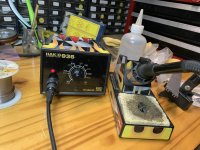Using Pb-free solder (99.3Sn/0.7Cu from Radio Shack when they went out of business ), I run at 380C for thru-hole components and 400-420C for connectors. I find 380C on the components is sufficient to make the solder joint in 2-3 seconds. My iron is a Hakko FX-888 with the stock tip.
), I run at 380C for thru-hole components and 400-420C for connectors. I find 380C on the components is sufficient to make the solder joint in 2-3 seconds. My iron is a Hakko FX-888 with the stock tip.
I know a lot of people love their 60/40 or 63/37 Sn/Pb solders, but why make your house into a toxic waste site? I only made the switch to Pb-free recently, mainly so that my kids wouldn't have to handle Pb while I teach them to solder. If the Radio Shack stuff works fine, then I imagine anything you get from Digikey or Mouser should be fine, too.
I know a lot of people love their 60/40 or 63/37 Sn/Pb solders, but why make your house into a toxic waste site? I only made the switch to Pb-free recently, mainly so that my kids wouldn't have to handle Pb while I teach them to solder. If the Radio Shack stuff works fine, then I imagine anything you get from Digikey or Mouser should be fine, too.
I used to work in the electronics industry for nearly 19 years and did a lot of soldering. The answer isn't as simple as a single setting.and why?
Rule of thumb was 325 °C for Sn/Pb and 350 °C for Pb-free.
However, "as low as you can get it to get the job done in the normal time" was advice I also given during trainings.
One of the most common mistakes people made when a joint turned out to be hard to make because of some more copper mass drawing heat away was simply increasing the soldering temperature. This does add more heat in a given time, but it also create other problems like burning the flux away before it can do its job or heatstressing components.
The option I preferred was going up in tip size. This increases the mass adding heat relative to the mass trying to draw it away. More than not this was all that's needed to get the joint done without increasing the temperature. The bigger size tip wasn't typically a problem as the smaller joints in spaces with less room to work on them didn't draw that much heat away to cause problems to begin with.
Of course this necessitated multiple tip changes, but that's where JBC solder stations came in handy.
Ha ha funny you should mention that about increasing temps. I use temps anywhere between 320C and 380C-ish depending on the job, generally using 0.71mm 60/40 Pb/Sn. And I do what you say, rather than change tips, because I'm a bit slack I guess. 
I'll change to a bigger tip for large copper planes if I have a few joints to solder, but if it's just for (say) large capacitor leads, I'll commonly just get out a fixed temp 25w or 60w iron I have which get to about 450C and have chunkier tips.
For the record, I have a really basic (but I think good) Micron brand analogue variable temp station made by Xytronic for a local store. It's around 20 years old and going strong. I mention this because I'm just going by the analogue dial temperature display, which I've never checked for accuracy.
I'll change to a bigger tip for large copper planes if I have a few joints to solder, but if it's just for (say) large capacitor leads, I'll commonly just get out a fixed temp 25w or 60w iron I have which get to about 450C and have chunkier tips.
For the record, I have a really basic (but I think good) Micron brand analogue variable temp station made by Xytronic for a local store. It's around 20 years old and going strong. I mention this because I'm just going by the analogue dial temperature display, which I've never checked for accuracy.
That doesn't look like degrees Frankenstein to me...350 Deg. F
Art
Thank for the "tip!" It totaly makes sense to with a bigger tip on bigger components. Now I know what's in my next Digikey|Mouser order. Too bad there aren't brick'n'mortar places to get this stuff anymore.One of the most common mistakes people made when a joint turned out to be hard to make because of some more copper mass drawing heat away was simply increasing the soldering temperature. This does add more heat in a given time, but it also create other problems like burning the flux away before it can do its job or heatstressing components.
The option I preferred was going up in tip size.
Yes, it's more about the speed of heat flow into the joint than tip temperature. So the tip size, shape and placement greatly affect the time needed.However, "as low as you can get it to get the job done in the normal time" was advice I also given during trainings.
One of the most common mistakes people made when a joint turned out to be hard to make because of some more copper mass drawing heat away was simply increasing the soldering temperature. This does add more heat in a given time, but it also create other problems like burning the flux away before it can do its job or heatstressing components.
It also helps to have a "little" molten solder on the tip before contacting the joint. This makes a larger heat path for quicker results than the single point of contact on a tip that has been wiped.
Called 'wetting' the tip.to have a "little" molten solder on the tip before contacting the joint
Jan
- Home
- Design & Build
- Equipment & Tools
- What temperature(s) do you run your soldering iron at?
